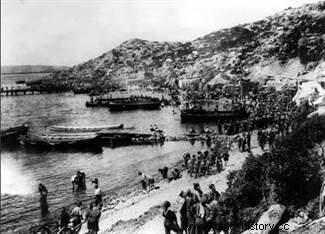 The Battle of the Dardanelles was a major Franco-British combined operation carried out during the First World War, between February 1915 and February 1916. Its objective was to force Turkey to peace and to establish a link with Russia, via the sea Noire, by seizing the strait of the Dardanelles. The establishment of a bridgehead in the Gallipoli peninsula cost the lives of many soldiers and the Allies encountered fierce resistance from the Turks commanded in particular by Mustafa Kemal, future Atatürk. Carried out with insufficient means, the Dardanelles expedition resulted in 144,000 killed or wounded (including 27,000 French). In Britain, this failure prompted Churchill to resign.
The Battle of the Dardanelles was a major Franco-British combined operation carried out during the First World War, between February 1915 and February 1916. Its objective was to force Turkey to peace and to establish a link with Russia, via the sea Noire, by seizing the strait of the Dardanelles. The establishment of a bridgehead in the Gallipoli peninsula cost the lives of many soldiers and the Allies encountered fierce resistance from the Turks commanded in particular by Mustafa Kemal, future Atatürk. Carried out with insufficient means, the Dardanelles expedition resulted in 144,000 killed or wounded (including 27,000 French). In Britain, this failure prompted Churchill to resign.
The objectives of the Gallipoli landing
This Dardanelles campaign was largely due to the will of the First Lord of the Admiralty (General Commander of the Royal Navy):Winston Churchill , to apply a peripheral solution to the problem of the stalemate of the western front. The choice of the allies falls on Gallipoli, a city and seaport in northwestern Turkey, in the province of Çanakkale, on a narrow peninsula extending to the Dardanelles.
 The takeover of the Gallipoli peninsula, according to Churchill, should lead to a rallying of Bulgaria and Greece to the Entente and consequently the opening of a second front against the Central Empires. On the other hand, it would make it possible to secure the freedom of communications with the precious Russian ally.
The takeover of the Gallipoli peninsula, according to Churchill, should lead to a rallying of Bulgaria and Greece to the Entente and consequently the opening of a second front against the Central Empires. On the other hand, it would make it possible to secure the freedom of communications with the precious Russian ally.
The Battle of the Dardanelles
However, reality will quickly dash his hopes. The naval offensive launched by the Allies on March 18 failed dramatically in front of Çanakkale; the French battleship Bouvet and two British battleships (Ocean and Irresistible) were badly damaged by floating mines. The naval bombardment campaign preceding the ground operation is a failure.
An invasion by land was then decided. An expeditionary force of four British divisions and one French division was formed; he landed on April 25 at two points off Cape Helles, at Seddülbahr and at Gapa-Tépé. The landing turns out to be much more difficult than expected. The Ottoman command was able to place its defensive device in critical places and the troops showed great resistance. They can count on competent officers, including a certain Mustafa Kemal…
A resounding failure for the allies
Despite three terrible clashes, on May 6, June 28 and July 12, 1915, the Allied troops, commanded by British General Hamilton, were never able to cross the Turkish lines that protected Istanbul . A new landing at Cape Suvla triggered other clashes (from August 6 to 23), with no more success for the Allies. Meanwhile, the battle at sea continued, with heavy French and British losses (8 out of 9 submarines were destroyed).
For the soldiers of the Entente, it was the beginning of an eight-month hell where the violence of trench fighting combined with logistical difficulties (in particular the supply of potable water). After several vain and bloody offensives, the allies finally evacuated Gallipoli during the month of December. The campaign will have cost more than 140,000 men to the Entente (and 250,000 to the Ottomans) and will be worth Churchill to lose his post of first Lord of the Admiralty.
To go further
- The Powder Magazine of the Orient, Volume 1:The Hell of the Dardanelles, by Pierre Miquel. Body 16, 2004.
- The Dardanelles 1915 - A failed strategy, by Rigoux Pierre. Economica, 2013.
